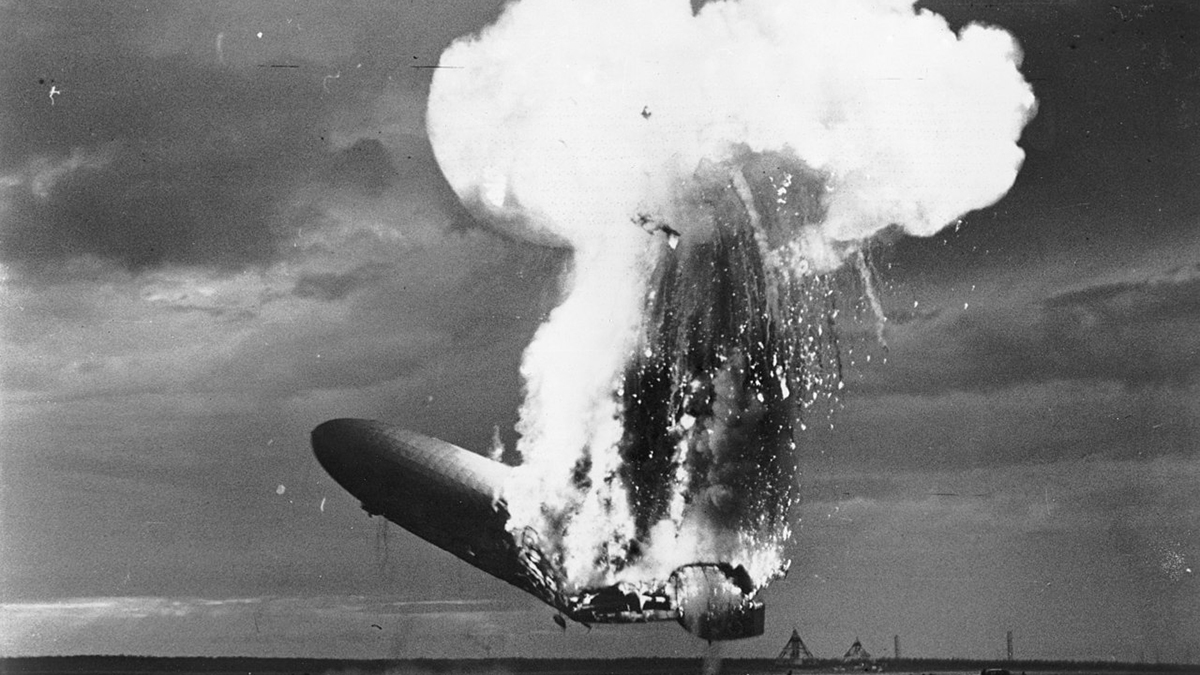The crash of the Hindenburg is one of the most iconic transport disasters of all time. Second only to the sinking of the Titanic, it’s been immortalised in popular culture, from Leadbelly’s contemporary song, to the cover of Led Zeppelin’s debut album, and films and novels. Journalist and eyewitness Herbert Morrison’s anguished cry, Oh, the Humanity! has also entered the popular lexicon.
Just as the Titanic was the largest ship afloat in its day, the Hindenburg was the largest man-made object to take to the skies. It took just 30 seconds to crash in flames, and that ended the era of commercial airship travel.
But there are many facts about the Hindenburg that might surprise you.
Firstly, the death toll was much lower than you might have assumed. Despite the horrific fireball, of the 97 passengers and crew, 62 survived. Many escaped by simply jumping out of the windows as the airship crashed, and running away.
In fact, the Hindenburg is not the deadliest airship crash. Not even the second. More people died in the crashes of the USS Akron in 1933 and the British military airship R101 in 1930.
The thousands of mail items on the Hindenburg were another story, though. Airships were the original trans-Atlantic airmail conveyances, and the Hindenburg carried some 17,000 items on its fatal voyage. Just 176 items, stored in a protective container, survived – charred, but legible.
Still, the massive, hydrogen-fuelled fireball put a definitive end to the public taste for airship travel.
Why even use highly flammable hydrogen, rather than inert helium? The earlier fiery crash of the R101 lead the Hindenburg designer Hugo Eckener to seek to use helium in his airship. But the United States had a monopoly on helium at the time and banned its export, fearing its use for military purposes.
Oddly, despite being filled with 7 million cubic feet of highly combustible hydrogen gas, the Hindenburg was not quite a non-smoking area. In fact, the airship had a dedicated smoking room. Still, mindful of saftey, the room was pressurised to prevent hydrogen leaking in and would-be smokers had to enter through a double-door airlock. Matches and personal lighters were verboten, though: there was a single electric lighter in the smoking room, and a steward made sure that no one left with a lit cigarette or pipe.
The Indiana Jones films are not known for their rigorous historical accuracy, so when Indy and his dad board a German airship in 1938, they supposedly do so after the Hindenburg has put an end to commercial airship travel. Still, the film gives a good idea of the luxury of airship travel. Indeed, the Hindenburg’s fittings included a custom-made lightweight baby grand piano. Made of aluminium alloy, it weighed only about 180 kg. It also wasn’t on the fatal voyage, being used only in the airship’s first flying season.
Still, all that luxury came at a price: a one-way ticket cost a whopping $400: nearly $8,000 in today’s money. By comparison, a first-class transatlantic ocean liner would set you back $157-240 ($3-4,500 today). Plebs paid $82 ($1,500) for a third-class ocean trip.
The Hindenburg was seen, until its crash, as a symbol of Nazi superiority. Indeed, its maiden voyage was a literal Nazi propaganda mission, flying across Germany for four days, blaring music and propaganda, and dropping leaflets and swastika flags. In 1936, it was decked in Olympic livery and played a starring role in the opening ceremony of the infamous Berlin Summer Games.
In fact, Nazi propaganda minister Joseph Goebbels had wanted the airship named after Hitler himself. But Hugo Eckener was a strident critic of the Nazi regime and named it after the late president and German elder statesman Paul von Hindenburg.
Eckener indeed had some cause to be grateful to Hindenburg. Eckener’s pioneering airship flight made him a national hero during the Weimar era. In 1932, Eckener had considered standing against Hitler in the presidential elections but bowed out in favour of Hindenburg. After the Nazis’ rise to power, Hindenburg intervened to block a planned arrest of Eckener.
No doubt the Nazis were somewhat relieved that it was not the Adolf Hitler that crashed in flames in 1936. That happy event had to wait another nine years.
Please share this article so that others can discover The BFD

